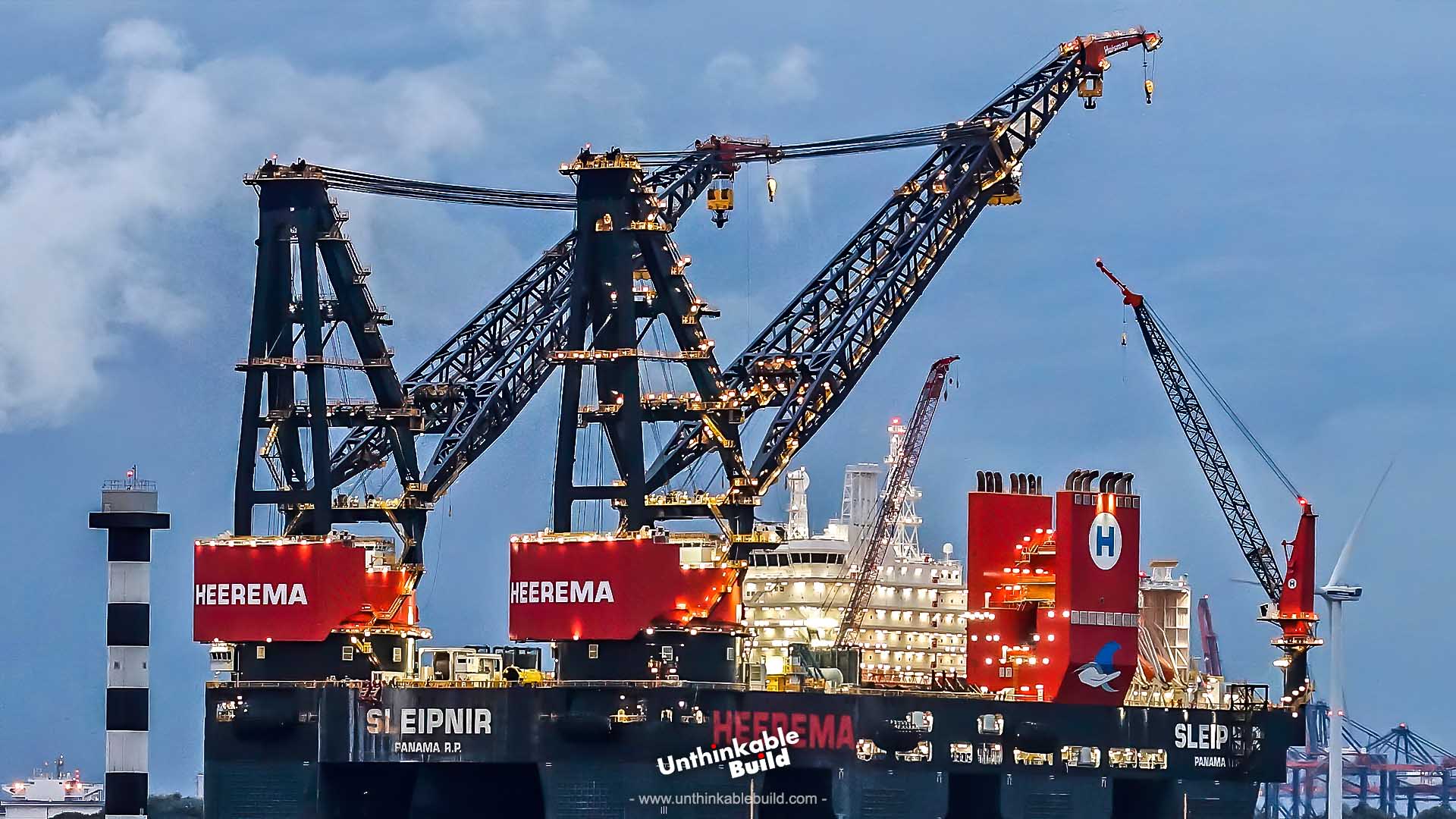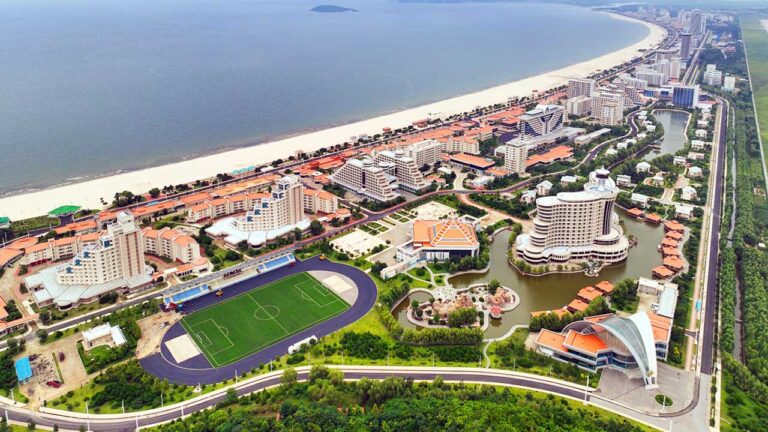Inside The World’s Biggest Crane Ship Ever Built
Crane ships might not always be in the spotlight, but they are the silent saviors of several maritime ventures. Imagine the challenge of building an oil extraction site far from shore or assembling a wind farm in the middle of the sea. This is where these giants of the water are equipped to handle the heavy lifting, literally. With cranes that can hoist loads well over 1,500 tons, they make it possible to move massive components and position them precisely, even in the most challenging conditions.
Let’s explore the fascinating story of the world’s largest semi-submersible crane vessels, the real heavyweight champions of the sea. What makes these SSCVs truly impressive is that they’re equipped with not one, but two massive cranes, and one of them holds the record for lifting an incredible 15,300 tons in a single go. These powerhouses have stood the test of time and remains hard at work to this day, proving that some giants only get better with age.
The history of Crane Vessels or Semi-Submersible Crane Vessel goes back to the 14th century, and their evolution reflects human innovation. Today’s versions are high-tech and designed with safety and efficiency at the forefront, reflecting centuries of innovation.
SSCV Sleipnir
The SSCV Sleipnir is a true marvel of modern engineering, owned by Heerema Marine Contractors of Netherlands. Named after the legendary eight-legged horse from Norse mythology, this vessel is one of the largest and most advanced crane ships in the world.
Also Read: This Is How Airplane Engines Are Tested for Safety
Built in 2019 by Singapore-based Sembcorp Marine, a subsidiary of Jurong Shipyard, this giant vessel likely came together piece by piece, with parts fabricated in different locations and then transported to the Tuas Boulevard Yard in Singapore for its final assembly.
Weighing in at 273,700 tons, SSCV Sleipnir is fitted with two gigantic cranes, each capable of lifting astounding 10,000 metric tons. To see it in a different light, that’s like lifting the weight of 3,000 elephants at once. Stretching 220 meters in length, 102 meters in width and 219 meters in height, this floating giant is also remarkably forward-thinking – it can run on cleaner, emission-reducing LNG fuel. Its unique design, with eight sturdy columns and streamlined platforms, helps it cut through waves and stay steady, even when the sea gets rough.
With a transit draft of 12 meter, Sleipnir can ballast down 39 meters when working. This is achieved by flooding the ballast tanks with seawater. It’s especially useful when the vessel can’t anchor to the seabed, providing the stability needed for secure and optimal performance. This incredible vessel is a key player in offshore construction projects around the world, proving that sometimes bigger really is better.
The Sleipnir’s primary cranes can extend an incredible 129 meters from the vessel. While most crane vessels struggle with deep-sea lifting, the Sleipnir can lift 1,000 tons from a depth of 1,000 meters, and an impressive 240 tons from as deep as 3,000 meters. This allows it to reach places no other crane has gone before.
What makes these capabilities possible is some truly massive engineering. The cranes are held in place by 1,100 ultra-large bolts, each weighing 88 pounds, and they rotate on 30-meter-wide bearings—the largest in the world. This combination of strength and stability allows the Sleipnir to tackle even the most challenging tasks in the deep sea.
The SSCV Sleipnir is practically a floating city, complete with a helipad and living accommodations for 400 workers. Its cutting-edge dynamic positioning system can keep the vessel precisely within a single square meter of its target location, no matter the conditions.
In September 2019, the Sleipnir made history in the Eastern Mediterranean while assisting with the development of Leviathan natural gas field. It pulled off an astonishing feat by lifting a 15,200-ton platform deck onto the Leviathan oil platform spar—a record-breaking achievement that had never been done before. Since then, the Sleipnir, with its mighty cranes, has been hard at work in the North Sea, helping Germany, the UK, Denmark, and other countries maintain oil and gas platforms, install wind farms, and complete countless other vital projects.
SSCV Thialf
There’s another vessel that really takes things to the next level. This is SSCV Thialf, the second largest Semi-Submersible Crane Vessel in the world by weight, and it really makes a statement. This vessel is a giant among SSCVs, finished in 1985 by the Japanese firm Mitsui Engineering & Shipbuilding for McDermott International, USA, it was later snapped up by the Dutch company Heerema Marine Contractors in 1997. For a long time, it retained the title of the world’s largest crane vessel until 2019, when the SSCV Sleipnir claimed the top spot.
Weighing 136,709 tons, SSCV Thialf is less than half the weight of Sleipnir. Despite this, it stretches an inspiring 201.6 meters in length, 88.4 meters in width, and stands 144.0 meters tall. The vessel has transit draft of 11.9 meters and can be ballasted down to a lift draft of 31.6 meters. With its two enormous cranes, SSCV Thialf can lift an incredible 14,200 metric tons, making it a powerhouse in the world of heavy lifting.
Its cranes can extend up to 31.2 meters and reach an impressive depth of up to 850 meters, allowing it to handle tasks in much deeper waters. Besides housing 736 workers, the SSCV Thialf comes with a fully equipped helicopter pad and a saturation diving chamber. This diving chamber is a necessary feature, especially for operations that require divers to spend weeks underwater.
This giant has been part of some impressive projects throughout its career. It helped install the pylon of the Erasmus Bridge of Rotterdam in 1995 and played a key role in decommissioning the Brent Spar in 1998. Known for its versatility, the Thialf is just as capable in shallow waters as it is in the depths of the sea.
Also Read: Can China’s New Giant Aircraft Carrier Fujian Really Dominate the Seas?
Saipem 7000
This is Saipem 7000, a true giant in the world of SSCV, and it’s hard not to be impressed by its sheer scale and capability. Initially called the Micoperi 7000, this massive vessel, weighing 117,812 tons is the 3rd largest by weight with an imposing presence on the water. Imagine a vessel with two massive cranes, each capable of lifting 7,000 tons. This incredible strength makes Saipem 7000 a go-to for some of the toughest offshore jobs, especially in the deepest waters where other vessels might struggle.
At 198 meters long and 87 meters wide, the Saipem 7000 has an interesting history that traces back to its construction by the Italian engineering firm Fincantieri, between 1985 and 1987. It is designed to remain stable and secure even in stormy weather, equipped with an advanced dynamic positioning system and 12 thrusters. This technology ensures the vessel remains precisely where it needs to be, which is crucial for protection and exactitude in complex operations.
The Saipem 7000 has a normal draft of 10.5 meters below the waterline, but when it needs to take on heavier tasks, its draft increases to 27.5 meters. The lifting capacity of Saipem 7000 is truly the star of the show. Each of its two primary cranes, mounted at the port and starboard bow, can handle a massive 7,000 tons, giving the ship a combined lifting capacity of 14,000 tons. These cranes are capable of extending up to 45 meters from the vessel while reaching up to 450 meters below the waterline to pick up or place objects.
But that’s not all. The Siem 7000 also has two auxiliary cranes. The larger crane can lift up to 2,500 tons, while the other one handles up to 900 tons. The Saipem 7000 can accommodate up to 725 people, providing comfortable living quarters for crew members who might be out at sea for months.







